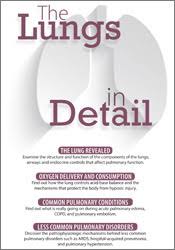Available for Pre-Order. This product will be available within a few days.
Angelica Dizon – The Lungs in Detail
THE LUNG REVEALED – Examine the structure and function of the components of the lungs, airways and endocrine controls that affect pulmonary function.
OXYGEN DELIVERY AND CONSUMPTION – Find out how the lung controls acid/base balance and the mechanisms that protect the body from hypoxic injury.
COMMON PULMONARY CONDITIONS – Find out what is really going on during acute pulmonary edema, COPD, and pulmonary embolism.
LESS COMMON PULMONARY DISORDERS – Discover the pathophysiologic mechanisms behind less common pulmonary disorders such as ARDS, hospital-acquired pneumonia, and pulmonary hypertension.
Slowly and silently your lungs pull air in and out several times a minute – sometimes slowly, sometimes rapidly, always with perfect control. When things go wrong, the lungs can become incredibly complex organs to diagnose and treat.
Have you ever wondered why:
Patients who suffer respiratory arrest often complain of anxiety as much as 8 hours before they decompensate?
Pulse oximetry can be normal when your patient is having difficulty breathing?
Abnormal breath sounds form and what they mean?
If you have a hard time explaining to your patients about how a pulmonary embolism affects lung function or why some asthmatics can become hypoxic and stop breathing, then you need to go back to the basics with the help of a mentor who can really make the information easy and understandable.
Most of us learned our anatomy, physiology, and pathophysiology in school where we were focused primarily on passing the class. We memorized, we studied, but we quickly forgot.
Understanding the essential concepts of pulmonary anatomy, physiology, and pathophysiology will help you find patient complications faster and respond to them more appropriately. In addition:
You will communicate more effectively with physicians and your peers,
You will feel more confident,
You will provide safer and more effective care!
OUTLINE
The Lung Revealed
From Airway to Alveolar Capillary Membrane
The Mechanics of Breathing
Resistance and Compliance
Gas Exchange
Relating Form and Function: The Ins and Out, Wherefores and Whys of an Integrated Assessment
Oxygen Delivery and Consumption
Oxygenation, Ventilation and Perfusion
Oxyhemoglobin Dissociation Curve
Minute Ventilation (RR x TV)
Oxygen Delivery vs. Oxygen Demand
Common Pulmonary Conditions: How and Why They Upset the Balance
Acute Pulmonary Edema
Predisposing Factors: Begin with the End in Mind
Pathophysiology: Changes in Surfactant = Changes in Compliance and Oxygenation
Presentation and Emergent Management: It’s Over in a Flash!
COPD
Presentation: Why the Pursed lips and Barrel Chest?
Pathophysiology: It’s All About the Alveolar Septum!
Projected Clinical Course: PROACTIVE not Reactive!
Pulmonary Embolism
The Role of D-Dimer
An Integrated Approach to Assessment
Charting a Proactive Projected Clinical Course
Asthma
Pathology and Pharmacology
Airway Smooth Muscle
Edema
Infection and Inflammation
Rate Control
Less Common Pulmonary Disorders: Why They Take Your Breath Away
ARDS
Avian influenza, Various Viruses, Drowning and more…!
Assessment Findings…
Advanced Ventilation strategies…
Recruitment: APRV and HFOV…
Hospital-Acquired Pneumonia
Risk Factors and Reimbursement: Begin with the End in Mind
Risk Management: An ounce of Prevention is Worth a Pound of Cure!
Pulmonary Hypertension
Hypertension Pathophysiology: It Gets You Right in the Heart!
Hidden Clues: Relating Physical Assessment to Pharmacologic Management…
Would you like to receive Angelica Dizon – The Lungs in Detail ?
OBJECTIVES
Compare and contrast negative-pressure ventilation with positive-pressure ventilation.
Describe the relationship between ventilation and perfusion.
Compare and contrast normal and abnormal chest x-ray findings.
Describe the desired outcomes of properly applied mechanical ventilation.
Compare and contrast volume and pressure control mechanical ventilation.








